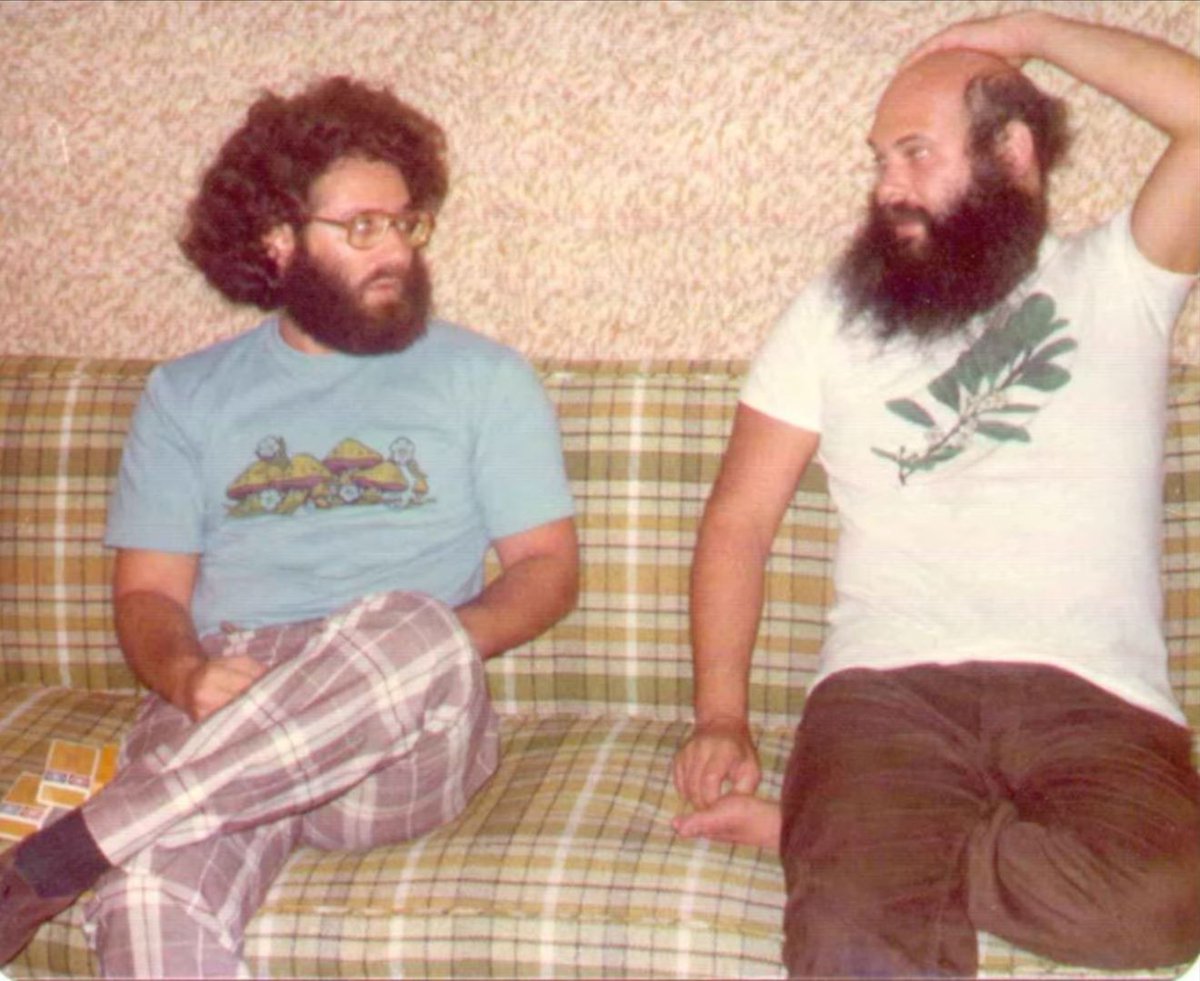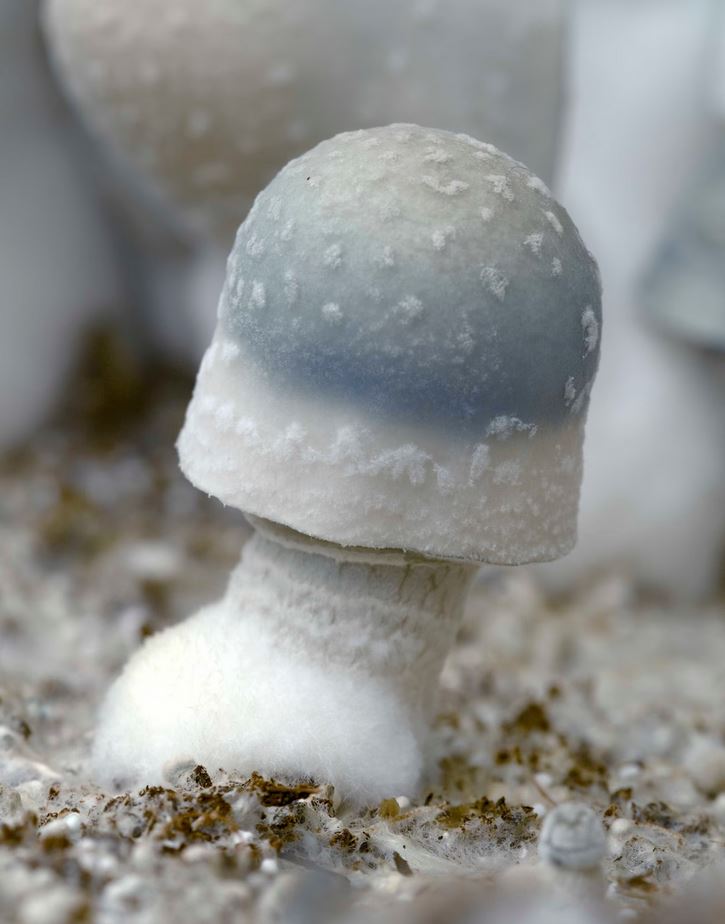
Steven Pollock was a doctor, researcher, mycologist & author that discovered psilocybin truffles & then became the largest distributor of them in the world.
He was murdered at the age of 33 & despite ample evidence, no one was ever charged.
A🧵on the mysterious man & his murder:


He was murdered at the age of 33 & despite ample evidence, no one was ever charged.
A🧵on the mysterious man & his murder:



Pollock was born in 1947 in LA and would go on to graduate from the Medical College of Wisconsin in 1975. He took a research job at University of Texas Department of Pharmacology but spent his nights researching, growing & isolating different strains of psilocybin mushrooms. 

He focused on making magic mushrooms accessible to the home grower by trying thousands of combinations between different mushroom species and growing substrates.
Seeds, grass, coffee grounds, corn, oats, Purina dog chow, truckloads of manure, Pollock tried it all.


Seeds, grass, coffee grounds, corn, oats, Purina dog chow, truckloads of manure, Pollock tried it all.



Pollock eventually settled on brown rice as a substrate, publishing the book "Magic Mushroom Cultivation" in 1977. Brown rice was selected because it produced mushrooms with particularly high psilocybin content. The method is still alive today:

https://twitter.com/FatherMcKennaa/status/1592239667625463808?s=20

One of Pollock's biggest discoveries came in Tampa in 1977. He had arrived at the 2nd International Mycological Congress and while waiting in his RV(a mobile shroom lab) outside, he met fellow mycologist Gary Lincoff, who was immediately interested in Pollock. 

The two made the decision to skip the conference that day and search for new mushroom species. The discovery they made that day, the mushroom Psilocybe tampensis, would change Pollock's life forever. 

P. Tampensis produce scerlotia, or truffles, that contain psilocybin yet were not technically illegal, making them the perfect gray-market opportunity for Pollock. A few other psilocybin species also produce scerlotia, but none to the size or extent of P. tampensis. 

Steven called the strange fungal growths "Philospher's Stones", and in 1979 created a company, "Hidden Creek" to sell them by mail. Hidden Creek advertised in the magazine High Times and became the largest psilocybin distributor the same year. 



Pollock also traveled frequently during 1979 & discovered three new psilocybin species: P. armandii, P. wassoniorum & P. schultesii.
The downside to this was that thieves began robbing his home. He installed steel bars & Paul Stamets taught him hwa rang do, a Korean martial art.


The downside to this was that thieves began robbing his home. He installed steel bars & Paul Stamets taught him hwa rang do, a Korean martial art.



As business ramped up, Pollock became obsessed with a new goal: a $2 million mushroom superlab. The $50,000 in profits per month from his mushroom business wasn't enough, he needed another hustle. Thanks to his doctorate, he could prescribe drugs & began taking advantage of this.
He set up a "pharmacy" in the building across his home & would help anyone that came in. His ethics varied- he would often over-prescribe drugs but also offered free care to low income families. He performed gun-wound surgeries in his kitchen with a promise not to call the police 

He landed into hot water as the Texas Pharmacy board began investigating his practice in 1980 after finding one pharmacy with 10,000+ Quaalude tablets issued under Pollock's name. Two police officers went undercover and both got prescriptions. His license would surely be lost. 



Another plan he hatched to raise funds for his superlab was a multiple-acre plot of cannabis he planted in 1980. Unfortunately this caught the attention of the DEA who were monitoring the site with recon planes and convened a grand jury to bring charges against Pollock. 

With his behavior more erratic and the walls closing in, Pollock was losing friends, frustrating his girlfriend & angering business partners. He thought it would all be OK if he just got the money for his superlab- he had applied for a patent on his Philospher's Stones after all.
The night of January 31, 1981 wasn't unusual- Pollock was working late at his pharmaceutical practice, up to his elbows in patients. After he finished, he planned to head to his GFs house for dinner. At 9:30 Paul Stamets called Pollock to give him a reference for his patent. 

The conversation was interrupted three times by Pollock attending to patients, leaving Stamets frustrated. Pollock hung up the final time, telling Paul, "Some patients have pulled up for treatment. I’ll call you right back after they leave."
Pollock never called back.
Pollock never called back.
His girlfriend, not hearing from him, called Steven multiple times before heading over to his house. Unusually, the front door was locked. She went in through the back, finding Pollock's body with a gunshot wound to the head & a ransacked house.
When police entered Pollock's greenhouse, they discovered 1,753 qt jars of growing magic mushrooms, 10lbs dried sclerotia, outdoor mushroom beds, jars of purple honey & numerous agar slants / spore prints. Despite protest from Pollock's father, the police burned everything. 

So who killed Pollock? This is where things get murky. The police had main three suspects: two drug-dependents that relied on Pollock's pharmacy, and one methamphetamine dealer. But with those that knew Pollock personally, rumors flowed. 

There were also a number of weird details, like "a bloody towel in Pollock’s bathroom, an unexplained bullet hole in the garage door, the way his records had been rifled through in an attempt to hide or emphasize certain patient data, and two mysterious phone calls". 

Another darker theory is that Pollock had hired a hit on the undercover cops, a hit which would eventually be turned on him: 

A confidential informant gave a tip in 1983, that led to a "gift case". They were patients of Pollock who openly bragged about killing him, had fingerprints in his house & his credit card was found on the way to their apartments. They were never charged. 

When the journalist @HamiltonMorris inquired about the case in 2011, no one, not even the detectives or DA involved, had any answers for him. All evidence had been destroyed by the DEA.
How convenient.
How convenient.
The final hidden clue is a mysterious tape that fell into the hands of Hamilton Morris, a tape stolen from an unmarked police car. This tape has two people discussing the murder of Pollock, but we will never know exactly who did it. 

But we do know who covered it up.
In 2011, @PaulStamets made it clear to Hamilton Morris: "You know, Steve was assassinated by the police."
In 2011, @PaulStamets made it clear to Hamilton Morris: "You know, Steve was assassinated by the police."

@PaulStamets This thread is dedicated to the memory of Steven Pollock, a revolutionary mycologist that propelled the psychedelic community forward in multiple ways. Next time you have psilocybin truffles, remember where they came from.
[Pollock pictured with Andrew Weil]
[Pollock pictured with Andrew Weil]

My main source was the fantastic article "Blood Spores" by @HamiltonMorris which is beautifully written & goes into much greater detail than my thread.
harpers.org/archive/2013/0…
harpers.org/archive/2013/0…
All my threads for your viewing pleasure:
https://twitter.com/FatherMcKennaa/status/1564672850765967360?s=20
• • •
Missing some Tweet in this thread? You can try to
force a refresh

























